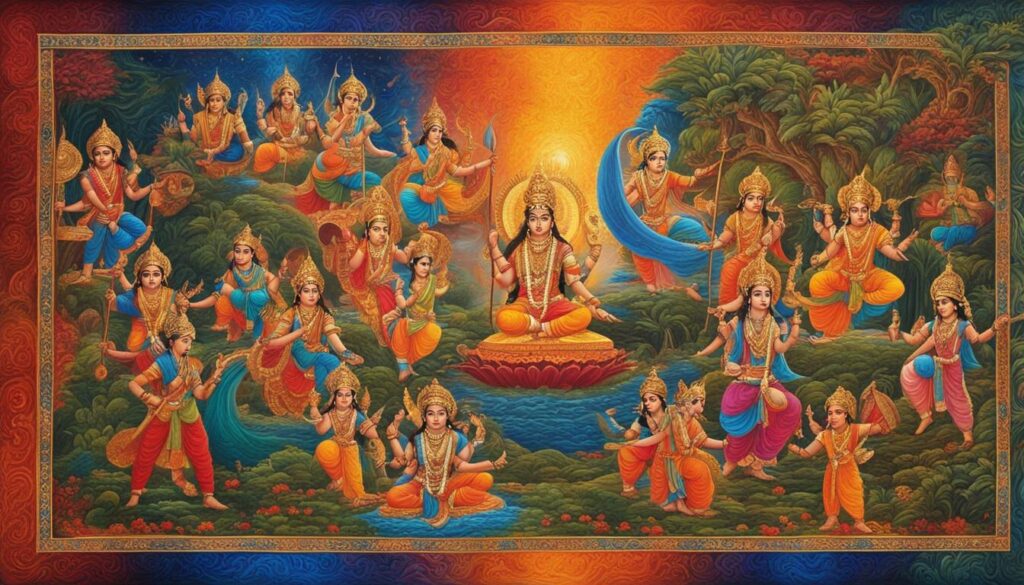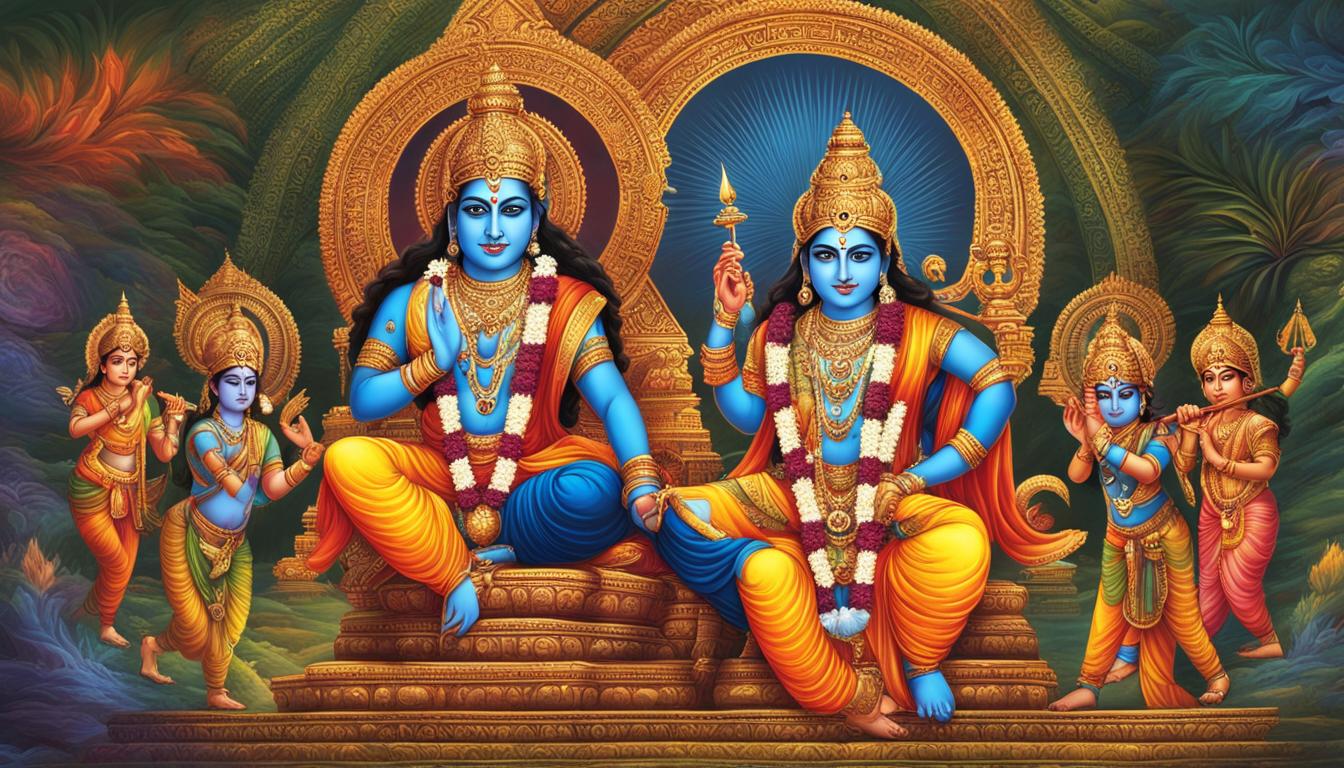In Hindu literature, the Puranas and the Ramayana hold significant positions, but they differ in their purpose and focus. The Puranas are a collection of written descriptions that narrate universal history, discussing myth, legend, and history. On the other hand, the Ramayana specifically tells the captivating story of Rama and his quest to rescue his wife, Sita, from the demon king Ravana.
The Puranas and the Ramayana both contribute to the rich tapestry of Hindu scriptures, offering unique insights into the diverse aspects of Hindu culture and mythology. Understanding the differences between these two texts can provide a deeper appreciation for the depth and breadth of Hindu literature.
Key Takeaways:
- The Puranas and the Ramayana are important texts in Hindu literature with distinct purposes and themes.
- The Puranas encompass a wide range of topics, including mythology, cosmogony, and history.
- The Ramayana focuses primarily on the story of Rama and explores themes of righteousness, loyalty, and the triumph of good over evil.
- Both texts contribute to a comprehensive understanding of Hinduism and its rich traditions.
- Studying both the Puranas and the Ramayana can provide valuable insights into the beliefs and values of Hindu culture.
Significance of Puranas in Hinduism
The Puranas hold great significance in Hinduism, serving as important literary works that contribute to the religious and cultural fabric of the religion. These ancient texts provide a comprehensive understanding of Hindu mythology, history, and culture, offering valuable insights into the traditions and beliefs of Hinduism.
The Puranas play a vital role in preserving and transmitting knowledge about various gods and goddesses, cosmogony, and mythical and historical events. They contain detailed accounts of the genealogy of gods and sages, along with stories of creation and destruction. These narratives not only entertain but also educate and inspire devotion to the deities.
Moreover, the Puranas serve as a guide for rituals, practices, and ethical conduct. They contain moral teachings, philosophical insights, and stories that emphasize the importance of righteousness, compassion, and devotion. Through their diverse narratives, the Puranas celebrate the rich tapestry of Hindu mythology, providing devotees with a deep understanding of the Hindu universe and its deities.
Overall, the Puranas are a significant part of Hindu literature, offering a treasure trove of knowledge and wisdom. They contribute to the spiritual, cultural, and philosophical development of individuals and communities, keeping alive the rich heritage of Hinduism.
Understanding Puranas and Ramayana in Hindu Scriptures
The Puranas and the Ramayana are two significant texts in Hindu literature, each with its own unique narrative and purpose. While the Puranas encompass a wide range of topics, including mythology, history, and rituals, the Ramayana focuses primarily on the life of Rama and his journey to rescue his wife Sita from the demon king Ravana.
In the Ramayana, written by Maharshi Valmiki, the story unfolds with Rama, an incarnation of Lord Vishnu, embodying righteousness and embarking on an epic battle against evil forces. This narrative explores themes of loyalty, love, and the ultimate triumph of good over evil. Through the Ramayana, readers gain valuable insights into moral and spiritual guidance, emphasizing the importance of honor, duty, and staying true to one’s principles.
On the other hand, the Puranas serve as comprehensive accounts of various gods, goddesses, cosmogony, and significant events in Hinduism. They offer not only a detailed description of the Hindu universe but also act as guides for rituals, practices, and ethical conduct. The Puranas celebrate the diversity of Hindu mythology and provide a deeper understanding of Hindu culture and traditions.
Table: Comparing the Puranas and the Ramayana
| Puranas | Ramayana |
|---|---|
| Encompasses a wide range of topics, including mythology, history, and rituals | Focuses primarily on the life of Rama and his actions in the epic war against Ravana |
| Provides a comprehensive account of the Hindu universe | Explores themes of righteousness, loyalty, love, and the triumph of good over evil |
| Serves as a guide for rituals, practices, and ethical conduct | Offers moral and spiritual guidance, emphasizing the importance of honor, duty, and staying true to one’s principles |
Both the Puranas and the Ramayana contribute to the rich tapestry of Hindu scriptures, offering valuable insights into the traditions, beliefs, and cultural heritage of Hinduism. While the Puranas provide a comprehensive understanding of Hindu mythology and history, the Ramayana focuses on the moral and philosophical aspects of life through the epic journey of Rama. Together, these texts continue to inspire and guide generations of individuals seeking spiritual and ethical enlightenment.
Differences Between the Puranas and the Ramayana
While both the Puranas and the Ramayana are significant in Hindu literature, they differ in their scope and content. The Puranas encompass a wide range of topics, including cosmogony, mythology, history, and rituals. They discuss the pantheon of gods and goddesses and provide a comprehensive account of the Hindu universe. On the other hand, the Ramayana focuses primarily on the life of Rama and his actions in the epic war against Ravana. It has a narrower narrative scope but delves deep into the moral and philosophical aspects of life.
The Puranas, as a collection of texts, serve as a guidebook for Hindu rituals, practices, and ethical conduct. They provide detailed accounts of various gods and goddesses, their attributes, and their significance. The Puranas also contain stories that inspire devotion and teach moral lessons. With their vast coverage of myth, legend, and history, the Puranas celebrate the diversity of Hindu mythology and offer a comprehensive understanding of Hindu culture and traditions.
On the other hand, the Ramayana is a singular epic that revolves around the life and adventures of Rama, the seventh avatar of Lord Vishnu. It tells the story of Rama’s search for his wife Sita, who has been kidnapped by the demon king Ravana. The Ramayana delves into themes of righteousness, loyalty, love, and the ultimate triumph of good over evil. Through Rama’s journey, the epic teaches important lessons about moral values, duty, honor, and the significance of upholding one’s principles.

Differences in Scope and Focus
| Puranas | Ramayana |
|---|---|
| Encompasses various topics such as cosmogony, mythology, history, and rituals | Focuses primarily on the life of Rama and his actions in the war against Ravana |
| Discusses the pantheon of gods and goddesses | Revolves around the story of Rama, an incarnation of Lord Vishnu |
| Provides a comprehensive account of the Hindu universe | Delves deep into the moral and philosophical aspects of life |
Conclusion
The Puranas and the Ramayana hold immense significance in Hinduism, contributing to the rich tapestry of Hindu scriptures. While the Puranas provide a comprehensive understanding of Hindu mythology, history, and culture, the Ramayana focuses on the life of Rama and explores themes of righteousness, love, and the triumph of good over evil.
The Puranas serve as a guide for rituals and ethical conduct, offering insights into the diverse pantheon of gods and goddesses in Hinduism. They celebrate the cultural diversity and provide moral teachings that inspire devotion to the deities.
On the other hand, the Ramayana captivates readers with its gripping narrative, teaching invaluable lessons about honor, duty, and the importance of upholding one’s principles. It is a source of moral and spiritual guidance, emphasizing the triumph of good over evil.
Together, the Puranas and the Ramayana contribute to a holistic understanding of Hindu scriptures, connecting individuals to their religious heritage and providing a comprehensive framework for understanding the traditions and beliefs of Hinduism.
FAQ
What are the Puranas and the Ramayana?
The Puranas are a collection of written descriptions of important events in Hinduism, while the Ramayana is an epic that tells the story of Rama and his journey to rescue his wife Sita from the demon king Ravana.
What is the significance of the Puranas in Hinduism?
The Puranas hold great significance in Hinduism as they provide detailed accounts of various gods and goddesses, cosmogony, and mythical and historical events. They also serve as a guide for rituals, practices, and ethical conduct.
What themes does the Ramayana explore?
The Ramayana explores themes of righteousness, loyalty, love, and the triumph of good over evil. It teaches valuable lessons about honor, duty, and the importance of upholding one’s principles.
How do the Puranas and the Ramayana differ?
The Puranas encompass a wide range of topics, including cosmogony, mythology, history, and rituals, while the Ramayana focuses primarily on the life of Rama and his actions in the epic war against Ravana.
What is the purpose of the Puranas and the Ramayana in Hindu literature?
The Puranas provide a comprehensive understanding of Hindu mythology, history, and culture, serving as a guide for rituals and ethical conduct. The Ramayana, on the other hand, explores moral and philosophical aspects of life and offers spiritual guidance.



